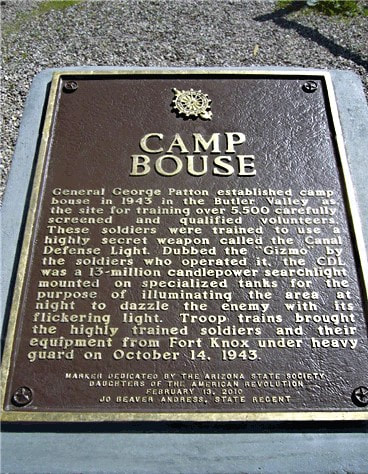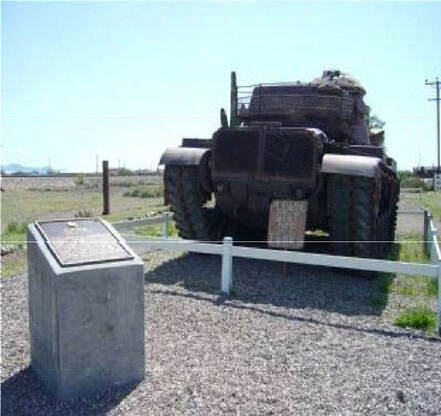World War II: Camp Bouse
Marker:
Camp Bouse
Location:
Butler Valley
La Paz County, Arizona
34.031007, -113.734817
Historical Significance:
In 1943, General George Patton established Camp Bouse as the top-secret site for training over 5,500 carefully screened and qualified volunteers. These soldiers were trained to use a highly secret weapon called the “Canal Defense Light.” This was dubbed the “Gizmo” by the soldiers who operated it. These tanks had modified turrets, carried a 13‑million candlepower searchlight that passed through a narrow slot, using shutters that opened and closed 6x/second. The tanks were designed to light up battlefields for nighttime frontal assaults. The flickering lights made it difficult for the enemy to see. Ultimately, it was felt that the lights could give the tank’s position away and make it an easy target for the enemy’s powerful anti-tank guns – so it was abandoned in 1944.
In August 1943, the 369th Engineer Battalion began constructing Camp Bouse. Among other features, a well was dug and water lines laid, concrete pads and sidewalks for the hospital and headquarters were poured, numerous roads and tent areas were graded, and a 500,000-gallon reservoir built. Camp Bouse was closed in April 1944. The men serving in the camp were transferred to Ft. Knox, Kentucky, and then to Kilmer, New Jersey. They were eventually sent to England for further combat training.
Dedicated:
February 13, 2010
Sponsor:
Arizona State Society, DAR
Rededicated:
February 8, 2010
Sponsor:
Arizona State Society, DAR


Request Membership Information
The content contained herein does not necessarily represent the position of NSDAR. Hyperlinks to other sites are not the responsibility of the NSDAR, the state organization or individual DAR chapters.
Unless otherwise noted, images are courtesy of Arizona State Society, DAR, Daughters.
